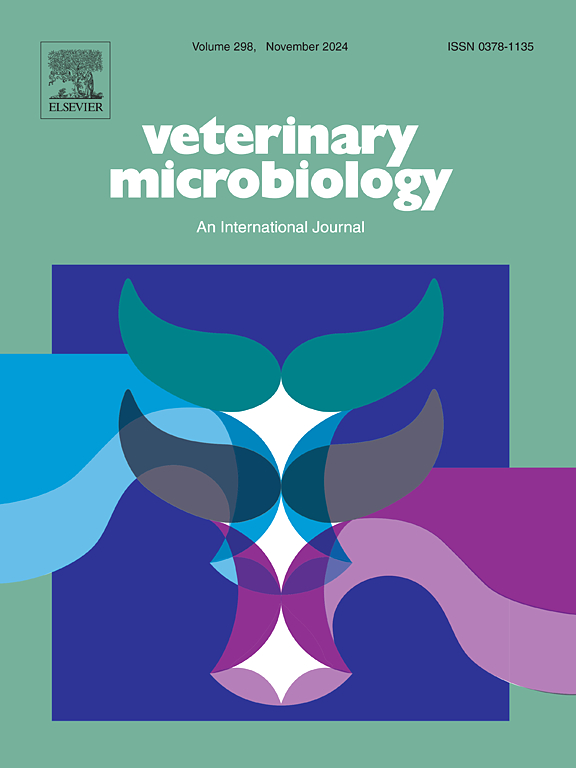在小鼠和狐狸感染的BALB/c小鼠模型中,11月的狐布鲁氏菌被减毒
IF 2.7
2区 农林科学
Q3 MICROBIOLOGY
引用次数: 0
摘要
由布鲁氏菌属引起的布鲁氏菌病是一种具有全球意义的人畜共患疾病,影响广泛的动物宿主。自从在野生动物中发现布鲁氏菌以来,在各种陆生和水生动物中分离出了属于布鲁氏菌属的新型细菌。其中,从两只红狐(Vulpes Vulpes)组织中分离出的布鲁氏菌分离株F60T和F965,于2016年被归为布鲁氏菌属;然而,在小鼠模型中的行为和致病潜力尚未研究。在本研究中,研究了B. vulpis F60T和F965对BALB/c小鼠的毒力和血清学反应,并使用B. suis 1330、B. microti CCM 4915和Brucella sp. 83-210作为系统发育上更远或非核心物种的代表,在小鼠模型中也显示出毒力。我们的研究结果表明,在104 CFU时,vulpis表现出较弱的感染模式,其在脾脏和肝脏中的持久性水平低于猪B. 1330,微B. CCM 4915和布鲁氏菌sp. 83-210,并且在小鼠中没有相关的死亡率。基于间接酶联免疫吸附试验(iELISA),与猪芽胞杆菌1330、微芽胞杆菌CCM 4915和布鲁氏杆菌83-210相比,狐芽胞杆菌F60T和F965引起了相似的血清学反应。这些结果表明,在小鼠感染模型中,与研究的其他毒性布鲁氏菌相比,至少对所研究的分离株而言,vulpb可以复制并被减弱。本文章由计算机程序翻译,如有差异,请以英文原文为准。
Brucella vulpis sp. nov. is attenuated in a BALB/c murine model of infection: Of mice and foxes
Brucellosis, caused by Brucella spp., is a zoonotic disease of global significance, affecting a wide range of animal hosts. Since the discovery of Brucella spp. in wildlife, novel bacteria belonging to the genus Brucella have been isolated across various terrestrial and aquatic animals. Among them are Brucella vulpis isolates F60T and F965 cultured from two red foxes (Vulpes vulpes) tissues, classified within the Brucella genus in 2016; however, the behavior and pathogenic potential of B. vulpis in a mouse model have not been investigated yet. In this study, the virulence and serologic response of B. vulpis F60T and F965 in BALB/c mice were investigated and compared using B. suis 1330, B. microti CCM 4915 and Brucella sp. 83–210 representative of phylogenetically more distant or non-core species, and previously shown to be also virulent in the mouse model. Our findings indicate that B. vulpis exhibits an attenuated infection pattern at 104 CFU, with lower levels of persistence in the spleen and liver than B. suis 1330, B. microti CCM 4915, and Brucella sp. 83–210, and no associated mortality in mice. B. vulpis F60T and F965 elicited a similar serologic response compared to B. suis 1330, B. microti CCM 4915, and Brucella sp. 83–210, based on an indirect enzyme-linked immunosorbent assay (iELISA). These results indicate that, in a mouse infection model, B. vulpis can replicate and is attenuated, at least for the isolates investigated, compared to the other virulent Brucella spp. studied.
求助全文
通过发布文献求助,成功后即可免费获取论文全文。
去求助
来源期刊

Veterinary microbiology
农林科学-兽医学
CiteScore
5.90
自引率
6.10%
发文量
221
审稿时长
52 days
期刊介绍:
Veterinary Microbiology is concerned with microbial (bacterial, fungal, viral) diseases of domesticated vertebrate animals (livestock, companion animals, fur-bearing animals, game, poultry, fish) that supply food, other useful products or companionship. In addition, Microbial diseases of wild animals living in captivity, or as members of the feral fauna will also be considered if the infections are of interest because of their interrelation with humans (zoonoses) and/or domestic animals. Studies of antimicrobial resistance are also included, provided that the results represent a substantial advance in knowledge. Authors are strongly encouraged to read - prior to submission - the Editorials (''Scope or cope'' and ''Scope or cope II'') published previously in the journal. The Editors reserve the right to suggest submission to another journal for those papers which they feel would be more appropriate for consideration by that journal.
Original research papers of high quality and novelty on aspects of control, host response, molecular biology, pathogenesis, prevention, and treatment of microbial diseases of animals are published. Papers dealing primarily with immunology, epidemiology, molecular biology and antiviral or microbial agents will only be considered if they demonstrate a clear impact on a disease. Papers focusing solely on diagnostic techniques (such as another PCR protocol or ELISA) will not be published - focus should be on a microorganism and not on a particular technique. Papers only reporting microbial sequences, transcriptomics data, or proteomics data will not be considered unless the results represent a substantial advance in knowledge.
Drug trial papers will be considered if they have general application or significance. Papers on the identification of microorganisms will also be considered, but detailed taxonomic studies do not fall within the scope of the journal. Case reports will not be published, unless they have general application or contain novel aspects. Papers of geographically limited interest, which repeat what had been established elsewhere will not be considered. The readership of the journal is global.
 求助内容:
求助内容: 应助结果提醒方式:
应助结果提醒方式:


